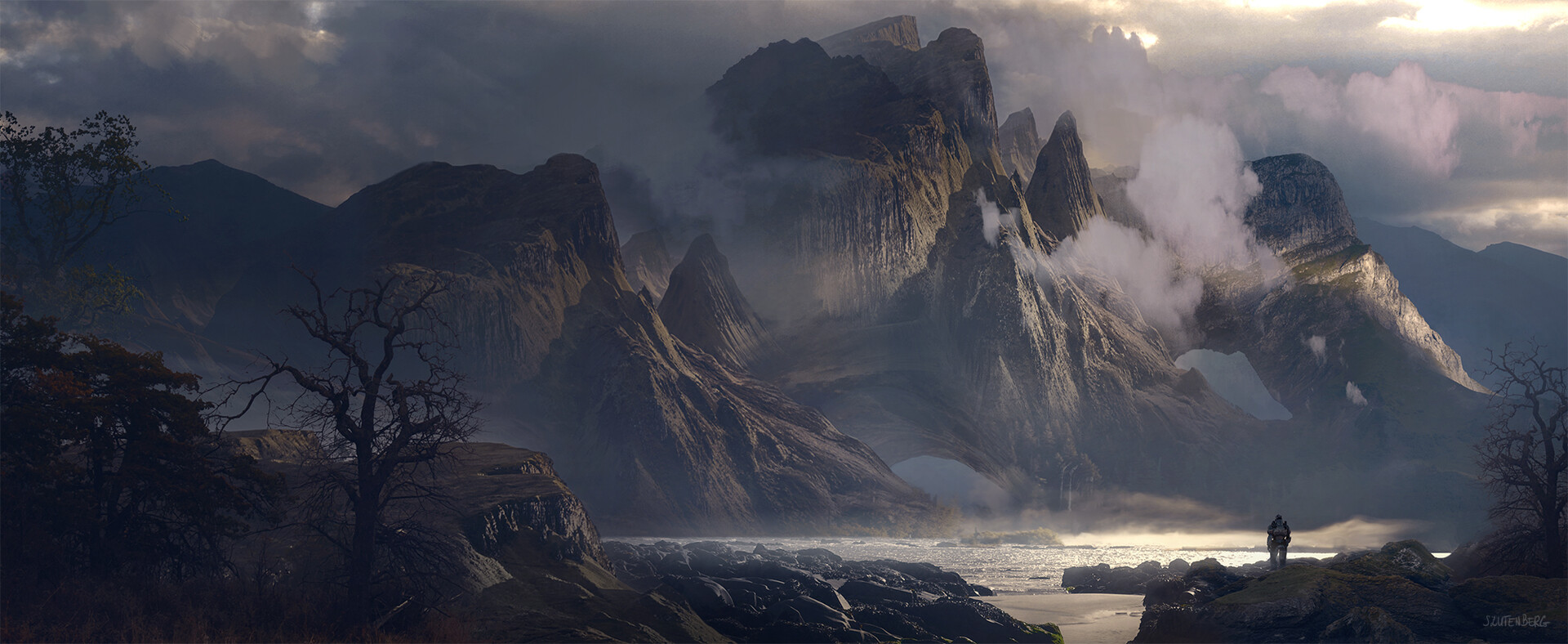Foggy Hills
by hughpierre
Geography
The foggy hills are a collection of collapsing buttes composed of igneous rock at the top and core and mostly sedimentary rocks surrounding the base and everywhere else. As sea levels changed repeatedly, gray-green shales became inbedded with yellow fine-grained sandstones, limestones, and sometimes thin, red beds of mudstone to create a rock resistant to weathering.
However, there are still significant tubes of lesser stone vulnerable to the pummeling waves and that dissolve in sea water. This layered combination of dissolvable and indissoluble left behind a series of well trodden waterways and pathways (depending on the season) both beneath and inbetween the hills' peaks.
Fauna & Flora
Present only during Flood Season
Water Tangle: It is uncertain for sure whether this is a plant or some marine animal. It is oddly transparent and is very reminiscent of seaweed except that it is carnivorous. Appearing harmless floating lazily a top water; anything that swims by it will be stung, not unlike that of a jellyfish, where after the tangle will by indeterminate means wrap itself around it's prey. Protrusions with the consistency of jelly but the shape and rigidity of a plant leaf rotate and anchor themselves and begin digesting and absorbing nutrients. Sea Spider: Not an actual spider; with 12 legs in total taking up the majority of its body mass. This creature feeds by nibbling on the soft parts of animals larger than itself. Dissectors have made note that this creature does not appear to have a heart, that it's guts circulate through its legs and those same legs are used to mate in place of genitalia. Crystal Shrimp: A primitive crustacean whose body is divided into head, thorax, and abdomen. Its body is covered with a thin, flexible exoskeleton of pale crystal to which muscles are internally attached.Present only during Dry Season
Handed Worms: Though acknowledged to be too big to be a worm, the name has stuck regardless in describing the boneless limb of a creature. On one end is a gangrenous tree-fingered hand, from where it gets its name. On the other, an eyeless and bulbous head with a human mouth. Bihorn: A two horned creature with a reddish-brown coat that covers most of it's body. The larger nasal horn, is the size of a baby's arm, while the other horn is typically a stub. Mostly a solitary animal except for courtship and offspring-rearing. It is a vocal species that also communicates through marking soil with its feet, twisting saplings into patterns, and leaving excrement.Present during Both Seasons
Spice Worms: Perhaps the only creature capable of living in the actual land of the Floodlands year round. Capable of bearing the high pressure, high-salt capacity and the sudden shredding of the great tsunamis churning waters and soil alike. Researchers at Gaioor are in constant awe of these creatures, in no small part of the spice drug secreted through their skins that helps to fund their work. The rough floods also seem to be crucial to their reproduction. As when sufficient force is applied to rip one spice worm apart, but not too much so, new spice worms grow from the pieces. They display a rainbow of colours depending on their situation. Normally a sandy brown, they turn purplish under the sun; a light green when broken and secrets a dark blue when burrowing. It's this blue that forms the spice melange that is collected to flavor local delicacies. Pearl Bank: The pearl bank doesn't look too impressive. They are most known for growing to great size and being thrown from the ocean's depths inland during the Floodland's semi-centennial flooding. Thought they can also be found at the foot of the shear cliff that drops the Brine Marshes into the sea. Head Crab: Six-appendage crustaceans with a soft leathery shell in place of a regular hard one. Their mouths are moved slightly lower in their chaises than what would be normal to better feed on slow moving bottom feeders.History
Imperial Golden Age
Cloud colonization was an organised colonial expansion by the clans into the northern and southern shores during the period of the empire. The 'northern shores' were in reference to the floodlines of the hanging valleys in the Valley of Man and the Brine Marsh. The 'southern shores' were in reference to the Foggy Hills in-between Ñuñu and Yates; and the opening into Giantsfall near the Floodgates.Painted Plagues
Through some unknown and malevolent force, the governor of Gaioor sought to gain a kingdom of his own. And in answer, a deluge of diseases crossed over from the Cold Swamp and, one after another, laid waste to the administrative framework across the empire's cities, coastal colonies and the capital itself.Post Plagues
With the establishment of the Imperial Cult, the Keanian Cult was pushed to the periphery of accepted Ñuñunan culture onto the Foggy Hills. Once the empire fell apart, the cultists remained on their rocky hills and were able to assert themselves onto the rest of the surviving population.To this day, the self-styled "Keepers of the Gate" rule over a religious oligarchy where everyone of their residence is taught to be faithful, elsewise the plagues would return. Though not a significant military power, they have managed to maintain their control by appeasing whichever power is on the rise at that time.
Trade Routes
Foggy Road
The winding land, then waterways, between the bumps of the Foggy Hills. The typical tunnel and canyon-like structures make it easy for the relatively small keanian cultists to extract tax or tribute for their use.
Type
Mountain / Hill
Location under
Contested By
Inhabiting Species

Ominous Oil Pastel Portrait by Ashley Dorney




Comments